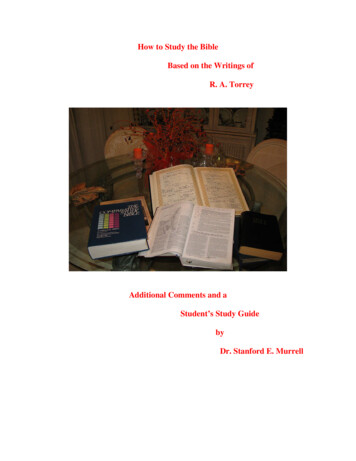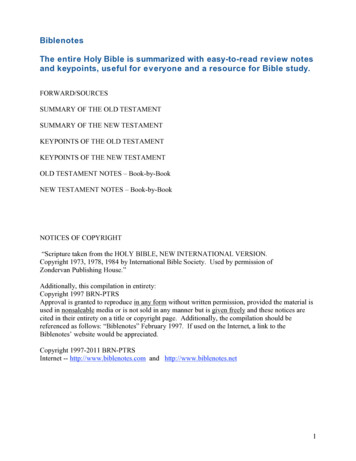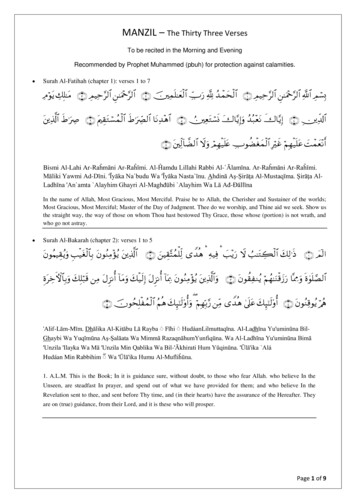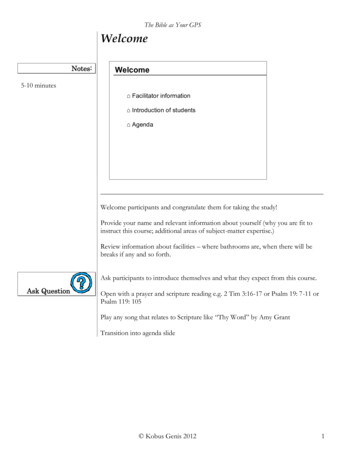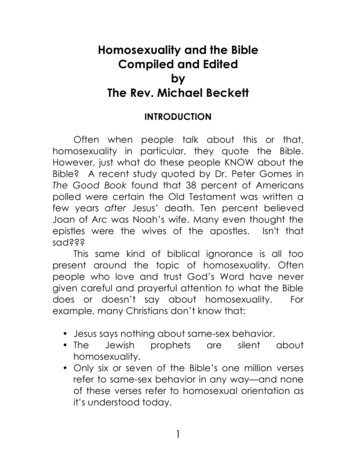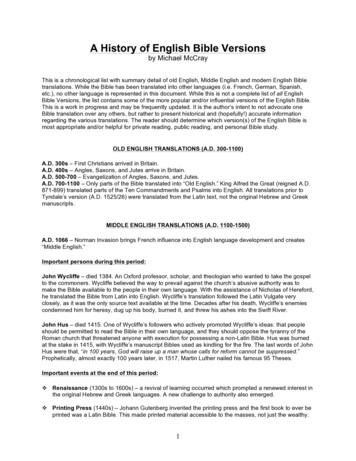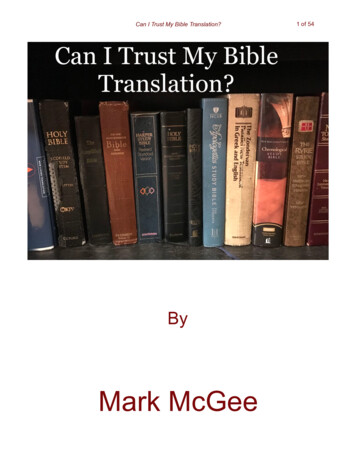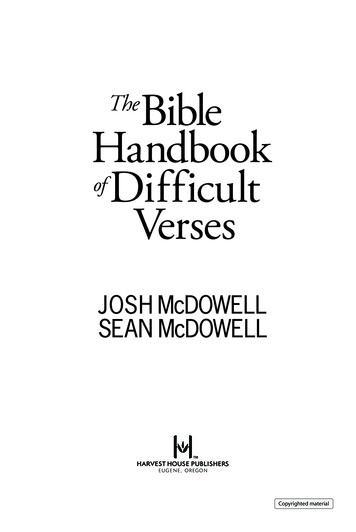
Transcription
Copyrighted materialBible Handbook of Difficult Verses, The.indd 312/21/12 3:05 PM
Unless otherwise indicated, all Scripture quotations are from the second edition of the Holy Bible,New Living Translation, copyright 1996, 2004, 2007 by Tyndale House Foundation. Used by permission of Tyndale House Publishers, Inc., Carol Stream, Illinois 60188. All rights reserved. Verses marked niv are taken from the Holy Bible, New International Version , NIV . Copyright 1973, 1978, 1984, 2011, by Biblica, Inc. Used by permission of Zondervan. All rights reservedworldwide. www.zondervan.com Verses marked nasb are taken from the New American Standard Bible , 1960, 1962, 1963, 1968,1971, 1972, 1973, 1975, 1977 by The Lockman Foundation. Used by permission. (www.Lockman.org)Verses marked nlt are taken from the first edition of the Holy Bible, New Living Translation, copyright 1996 by Tyndale House Foundation. Used by permission of Tyndale House Publishers, Inc.,Carol Stream, Illinois 60188. All rights reserved.Verses marked kjv are taken from the King James Version of the Bible.Verses marked nkjv are taken from the New King James Version. Copyright 1982 by Thomas Nelson, Inc. Used by permission. All rights reserved. Verses marked hcsb are taken from the Holman Christian Standard Bible , Copyright 1999, 2000,2002, 2003 by Holman Bible Publishers. Used by permission. Holman Christian Standard Bible ,Holman CSB , and HCSB are federally registered trademarks of Holman Bible Publishers. Cover by Koechel Peterson & Associates, Inc., Minneapolis, MinnesotaTHE BIBLE HANDBOOK OF DIFFICULT VERSESCopyright 2013 by Josh McDowell Ministry and Sean McDowellPublished by Harvest House PublishersEugene, Oregon 97402www.harvesthousepublishers.comISBN 978-0-7369-4944-6Library of Congress Cataloging-in-Publication DataMcDowell, Josh.The Bible handbook of difficult verses / Josh McDowell and Sean McDowell.p. cm.ISBN 978-0-7369-4944-6 (pbk.)ISBN 978-0-7369-4945-3 (eBook)1. Bible—Criticism, interpretation, etc.—Miscellanea. 2. Apologetics—Miscellanea. I. McDowell,Sean. II. Title.BS511.3.M3365 2013220.6—dc232012033401All rights reserved. No part of this publication may be reproduced, stored in a retrieval system, ortransmitted in any form or by any means—electronic, mechanical, digital, photocopy, recording, orany other—except for brief quotations in printed reviews, without the prior permission of the publisher.Printed in the United States of America13 14 15 16 17 18 19 20 21 / LB-JH / 10 9 8 7 6 5 4 3 2 1Copyrighted materialBible Handbook of Difficult Verses, The.indd 412/21/12 3:05 PM
ContentsHow to Use This Handbook . 9The Pentateuch: Genesis–DeuteronomyDifficult Passages from Genesis . 24Exodus . 75Leviticus. 85Numbers . 98Deuteronomy .102The Historical Books: Joshua–EstherDifficult Passages from Joshua .108Judges . 110Ruth . 1121 Samuel . 1142 Samuel . 1141 Kings .1202 Kings.1201 Chronicles . 1252 Chronicles. 125Ezra. 127Nehemiah . 129Esther.130Poetry and Wisdom: Job–Song of SongsDifficult Passages from Job .134Psalms .136Proverbs . 139Ecclesiastes .143Song of Songs.1445Copyrighted materialBible Handbook of Difficult Verses, The.indd 512/21/12 3:05 PM
The Prophets: Isaiah–MalachiDifficult Passages from Isaiah. 146Jeremiah. 149Lamentations. 151Ezekiel. 155Daniel. 158Hosea. 160Joel. 162Amos. 164Obadiah. 167Jonah. 169Micah. 170Nahum. 172Habakkuk. 174Zephaniah. 176Zechariah. 178Malachi. 179The Gospels/Narratives: Matthew–ActsDifficult Passages from Matthew. 182Mark. 207Luke. 210John. 220Acts. 227Paul’s Letters: Romans–PhilemonDifficult Passages from Romans. 2341 Corinthians. 2382 Corinthians. 238Galatians. 251Ephesians. 253Philippians. 260Colossians. 2621 Thessalonians. 2672 Thessalonians. 267Copyrighted materialBible Handbook of Difficult Verses, The.indd 612/21/12 3:05 PM
1 Timothy. 2702 Timothy. 270Titus. 277Philemon. 279General Letters: Hebrews–RevelationDifficult Passages from Hebrews. 284James. 2901 Peter. 2922 Peter. 2921 John. 2992 John. 2993 John. 299Jude. 305Revelation. 309Notes. 315Index by Scripture Passage. 319Index by Topic. 333Copyrighted materialBible Handbook of Difficult Verses, The.indd 712/21/12 3:05 PM
AcknowledgmentsWe wish to recognize the following individuals fortheir valuable contribution to this handbook.Dave Bellis, my ( Josh’s) friend and colleague for 36years, for collaboration with us on all the passages covered in this handbook, researching the answers, writingthe rough draft, and folding in all our edits and revisionsto create the final draft. We recognize Dave’s insights andknowledge of Scripture and are deeply grateful for hiscontribution.Ken Turner for reviewing the manuscript and providing helpful insight in his areas of expertise.Becky Bellis for laboring at the computer to ready themanuscript.Terry Glaspey of Harvest House for his vision andguidance in shaping the direction and tone of this work.Paul Gossard of Harvest House for the expert editingand insight he brought to the manuscript completion.Josh McDowellSean McDowellCopyrighted materialBible Handbook of Difficult Verses, The.indd 812/21/12 3:05 PM
The PentateuchGenesis–DeuteronomyCopyrighted materialBible Handbook of Difficult Verses, The.indd 2312/21/12 3:06 PM
Difficult Verses fromthe Book of GenesisPassage:In the beginning (Genesis 1:1).Difficulty: Doesn’t science claim the universe is eternal? Ifso, how can it have a beginning?Explanation: The First Law of Thermodynamics states that matterand energy can be changed from one form to another, but it cannot becreated or destroyed. For centuries scientists believed the universe wasuncaused and eternal.In the early part of the twentieth century the scientific communitywas confronted with the ramifications of Albert Einstein’s general theory of relativity. Like most scientists of the day, Einstein assumed theuniverse was static and eternal. Yet his mathematical equation of relativity pointed strongly toward a universe that was either expanding orcontracting. While this seemed to unsettle him, Einstein later acceptedthat the universe had a finite past. Why did he change his mind?In 1929 cosmologist Edwin Hubble used his hundred-inch telescope to demonstrate that light from distant galaxies were shiftingtoward the red end of the light spectrum. This meant that the universewas expanding in all directions. This was a powerful confirmation ofEinstein’s findings that the universe is not static but at some point intime had a beginning.1 This first moment of existence is now referredto as the singularity, which is an edge or boundary to space-time itself.According to Professor Paul Davies at Oregon State University, “Forthis reason most cosmologists think of the initial singularity as thebeginning of the universe.”2This doesn’t mean that all scientists necessarily accept God as thebest explanation for the beginning of the universe, but most nowbelieve that the universe began to exist at a finite point in the past. Itappears that many in the scientific community have caught up with thebiblical declaration that “in the beginning ” (Genesis 1:1).24Copyrighted materialBible Handbook of Difficult Verses, The.indd 2412/21/12 3:06 PM
The Pentateuch25Passage:In the beginning God created the heavens and the earth(Genesis 1:1).Difficulty: Is there any evidence that God did in fact create the universe?Explanation: There is solid evidence that the universe had a beginning (see previous Explanation), but that doesn’t prove that God gavethe universe its beginning, right? And while many scientists now concede that the universe had a beginning, this doesn’t address who or whatcaused it. But there is evidence to confirm what Christians believe: thatGod is the Creator of the universe as Scripture states.One of the evidences that God created the universe is what is oftenreferred to as the first-cause argument for God’s existence, or the cosmological argument.The idea is that everything that begins to exist must have a cause.So if you go back in time far enough you will find the first cause—andthat cause will be an Intelligent Creator. Actually this argument hasthree premises:1. Whatever begins to exist has a cause.2. The universe began to exist.3. Therefore the universe has a cause.The first premise seems self-evidently true. Can you think of something that comes from nothing? Some try to evade this problem bydefining “nothing” as a quantum vacuum. But even vacuums aren’ttechnically nothing. They have energy and quantum particles, whichis something. We have no empirical evidence of something emergingwithout a cause from absolute nothing. The ancient Greeks were rightwhen they said, “Out of nothing, nothing comes.” It certainly seemsmore reasonable than to not believe that things that begin to exist havea cause.Copyrighted materialBible Handbook of Difficult Verses, The.indd 2512/21/12 3:06 PM
26The Bible Handbook of Difficult VersesThe second premise finds support from the second law of thermodynamics (see question on Genesis 1:1 for additional scientific evidence).That law states that usable energy within a closed system will eventuallyrun down. Since the universe is a closed system, its usable energy willeventually run down and the universe will reach a state of equilibriumknown as “heat death.” But the energy has not run down yet. Why not?The answer is simple: The past is finite. If the past were eternal, then theuniverse would have already run down at some point in the past.The last premise builds off the previous two: The universe has acause. This can lead us then to a conclusion based on the question,“Who caused the cause?” We can derive our answer from the origins oftime, space, and matter. It is logical to conclude that since time, space,and matter did not exist prior to the beginning of the universe, thenthe “cause” of the universe had to be timeless, spaceless, and immaterial. Further, this “cause” could not be physical or subject to natural law since that would presuppose its existence involved time, space,and matter. This then leads us to conclude that the timeless, spaceless, immaterial “cause” was in fact God. (For more details and otherevidences for the existence of God see the book Is God Just a HumanInvention? by Sean McDowell and Jonathan Morrow, described in theback pages of this book.)Passage:God said, “Let there be light,” and there was light (Genesis 1:3).Difficulty: Isn’t it contradictory to say light was created onthe first day, yet the sun wasn’t created until the fourth day?Explanation: Some have suggested that on the first day God created light, as well as all other types of what is called electromagneticradiation (EMR). Some who hold this view believe God created thelight of the sun and moon on the first day, but it only became visibleon the fourth day as the atmosphere of the Earth became transparent.Visible light is just a small part of the entire spectrum of EMR. TheCopyrighted materialBible Handbook of Difficult Verses, The.indd 2612/21/12 3:06 PM
The Pentateuch27visible light range or wavelength of what we can see with the nakedeye is from about 380 nanometers (NM) to about 740 NM. But theelectromagnetic spectrum is much broader. It extends from low frequencies used for radio broadcasts, which we cannot see to very highfrequencies of gamma radiation, which again are beyond our vision.This means electromagnetic radiation covers wavelengths from thousands of kilometers down to a fraction of the size of an atom. Whatwe see with the human eye is only a very small part of the electromagnetic spectrum.Scientists say that the electromagnetic spectrum in principle is infinite and continuous. Indeed, while Einstein’s theory of relativity predicts that time, space, and mass can all change due to relativistic effects,the speed of EMR is always constant in all frames of reference. Perhapsthat is why Jesus so aptly referred to himself as the “light of the world”( John 8:12)—God as the constant, infinite, and continuous one bringshis light to every dimension of the universe, from the distant stars to afraction of the diameter of a proton.On the very first day of creation God may have very well broughtinto existence the miraculous phenomenon of light along with theentire spectrum of electromagnetic radiation, ranging from the lowestof the low in frequency to the highest of the high. Then on the fourthday (Genesis 1:14-18), God formed the sun, moon, and stars to warmPlanet Earth and radiate light throughout the visible universe.The other possible response to this question involves asking a question about the nature of Genesis—“Was Moses trying to offer a scientific chronology of the creation event?” In other words, is the Genesis1 creation account meant as a scientific account of the sequence andmanner of creation? If yes, then some explanation such as the aboveis necessary. If no, then this difficulty disappears. See answer to Genesis 2:1-4 for alternative ways of understanding the creation account.Passage:God said, “Let us make human beings in our image, to belike ourselves” (Genesis 1:26).Copyrighted materialBible Handbook of Difficult Verses, The.indd 2712/21/12 3:06 PM
28The Bible Handbook of Difficult VersesDifficulty: Why does God refer to himself as “us”?Explanation: Some people suggest that God, being a Trinity (Father,Son, and Holy Spirit), is actually speaking among the three persons ofthe Godhead and therefore refers to himself as us. We know, for example, that the Holy Spirit, the third person of the Trinity, was at creationfor it says in Genesis 1 that “the Spirit of God was hovering over the surface of the water” (verse 2). Scripture also states that Jesus was at creation. “Through him God created everything in the heavenly realmsand on earth He existed before anything else, and he holds all creation together” (Colossians 1:15-17).We can then clearly conclude from other passages of Scripture thatthe three persons of the Godhead were present and actively engagedin creation of all things. So since God is Trinity, is that why God said,“Let us make human beings in our image?” The short answer is “Maybe.”There are three possible explanations for the plural pronoun in thispassage. The first option is, as we have seen, that the “us” and “our” passages refer to the Trinity. However, one difficulty with this interpretationis that the word “us” is actually part of a Hebrew verb, not a pronoun.The “our” is the first plural pronoun. As a result, some scholars believethe “us” is literarily meant to signal that the creation of humanity is special, rather than indicate the numerical plurality of the Creator.The second option is that the Hebrew word elohim gives a moreencompassing, grand, and majestic context of the person of God. Theplural name elohim is in the majestic plural (the royal “we” ) and shouldlead us to remember that God cannot be placed in a narrow singularbox. As the prophet Isaiah wrote,“My thoughts are nothing like your thoughts,” says theLord. “And my ways are far beyond anything you couldimagine. For just as the heavens are higher than the earth,so my ways are higher than your ways and my thoughts arehigher than your thoughts” (Isaiah 55:8-9).The third option is that the “us” refers to God and his heavenlycourt (that is, angels). While this interpretation does have some difficulties, it is a possible view held by a number of respectable evangelical scholars.Copyrighted materialBible Handbook of Difficult Verses, The.indd 2812/21/12 3:06 PM
The Pentateuch29Regardless of the proper interpretation of this passage, this in noway lessens the truth that God is triune. God has revealed his characterprogressively throughout history, and most fully in the person of JesusChrist ( John 14:7-9).Passage:God said, “Let us make human beings in our image, to belike ourselves. They will reign over the fish in the sea, thebirds in the sky, the livestock, all the wild animals on theearth, and the small animals that scurry along the ground.”So God created human beings in his own image. In theimage of God he created them; male and female he createdthem (Genesis 1:26-27).Difficulty: How are we humans like God? We don’t havethe infinite characteristics of God of knowing everythingand having all power, so what does it really mean to be created in God’s image?Explanation: Scripture teaches us that 1) God has life withoutbeginning or end (eternal, see Isaiah 40:28); 2) God is almighty andpowerful (omnipotent, see Job 42:2); 3) God is ever-present (omnipresent, see Jeremiah 23:23-24); 4) God knows all (omniscient, seeIsaiah 46:9-10); and 5) God is constant and will not change (immutable, see Psalm 102:26-27). And none of these Godlike characteristicshas been passed on to his human creation. And being created in God’simage doesn’t mean we look like him either, because “God is Spirit, sothose who worship him must worship in spirit and in truth” ( John4:24). We are physical beings—God is not. So what part of his imagedid we inherit from our Creator?Before there were humans, before the material universe or time andspace existed as we know it, God existed eternally as a loving relationalbeing. He is relational by his very nature, three personalities blendedin perfect harmony—Father, Son, and Holy Spirit. While he is theinfinite one and we as humans are finite, we bear his relational image.Copyrighted materialBible Handbook of Difficult Verses, The.indd 2912/21/12 3:06 PM
30The Bible Handbook of Difficult VersesWe have inherited his relational ability to love in a way that other creatures cannot. Scripture says, “Love comes from God for God is love”(1 John 4:7-8).As part of God’s relational image we have inherited the ability tocommunicate our thoughts, intents, and feelings to others throughcomplex language. Scripture repeatedly uses the phrase “God said,”showing us that relationships mean communication to others. Theability to express and enhance relationships by communicating isanother way we reflect the image of God.We have inherited his sense of value for human relationships andfor life itself. God said, “Honor your father and mother you mustnot murder you must not commit adultery you must not steal you must not testify falsely you must not covet your neighbor’s wife”(Deuteronomy 5:16-21). From God’s giving of the law at Mount Sinaiup through the early church and beyond, it was understood and taughtthat life is sacred at every stage. Promoting social justice, taking careof the poor, and defending human rights find their basis in each ofus because we are purposely created in God’s relational image—withvalue, dignity, and worth.We have inherited God’s sense of satisfaction and joy in accomplishing things through relationships. After each creative act in Genesis, thisrelational God “saw that it was good” (Genesis 1:10). The Father, Son,and Holy Spirit found joy in their collective creative acts as the Master of the universe.We inherited from the Master of the universe the charge to “reign”over all the creatures of the earth (Genesis 1:26). God told the firsthumans that in relationship with one another they were also to live inproper relationship with their home—Earth. God said to be stewardsof the earth and “to tend and watch over it” (Genesis 2:15). So Godinstilled within his human creation an environmental responsibility torelate lovingly to the planet they inherited.God placed humans on a plateau above the rest of creation whenhe fashioned them in his relational image and likeness. To summarize,this Godlikeness bestowed upon the human race certain gifts and obligations: to love God and one another as personsCopyrighted materialBible Handbook of Difficult Verses, The.indd 3012/21/12 3:06 PM
The Pentateuch31 to effectively communicate through complex language to be creative to think logically to make moral decisions to defend the dignity, value, and worth of all humanlife, to be the protector of peace and harmony among allpeople, and to preserve the unity and sanctity of marriagebetween a man and a woman and the family to rule over and be the steward of creationIt is this relational dimension with all its ramifications that distinguishes us as created in God’s image and gives us special meaning.Passage:God created human beings in his own image. In the imageof God he created them; male and female he created them.Then God blessed them and said, “Be fruitful and multiply.Fill the earth and govern it” (Genesis 1:27-28).Difficulty: Doesn’t the science of genetics refute the concept that the entire population of the world came from justone couple?Explanation: Over the past couple of decades researchers have used“population genetics” to estimate initial population size of the humanspecies. By studying human genetic diversity in the present day, theyhave tried to extrapolate back to determine the minimum size of theoriginal population of humans necessary to produce the diversity weobserve today. Some have argued that it is impossible for civilizationto have come from one human couple.Dr. Francis S. Collins is a physician and geneticist who in 2007formed the San Diego–based BioLogos Foundation. It is an organization that promotes theistic evolution among evangelicals. DennisR. Venema, PhD, a BioLogos senior fellow for science and biologyCopyrighted materialBible Handbook of Difficult Verses, The.indd 3112/21/12 3:06 PM
32The Bible Handbook of Difficult Verseschairman at Trinity Western University, is a writer for BioLogos. Hetoo is a theistic evolutionist who is trying to promote harmony of Darwinian science and faith within the evangelical community.Dr. Venema claims that human population “was definitely never assmall as two.” He contends that “our species diverged as a population.The data are absolutely clear on that.” 3 He asserts that to reach the level ofgenetic diversity we see today, the inital population of humans would havehad to be several thousand individuals at minimum—not one couple.Not all biologists, however, agree with Dr. Venema. Dr. Ann Gaugeris senior research scientist at the Biologic Institute, a pro–intelligentdesign research lab based near Seattle, Washington. She earned a PhDin biology from the University of Washington, and later did postdoctoral work at Harvard. In the chapter “The Science of Adam and Eve” inthe 2012 book Science and Human Origins, Gauger finds that Venema’sarguments were based upon a now outdated study of genes involved inthe human immune system that was published by the geneticist Francisco Ayala in 1995.According to Gauger, these population genetics studies make manyassumptions—including a constant background mutation rate, lackof natural selection, lack of migration, and a constant population size.If any of those assumptions are wrong then the conclusions could bemeaningless. Gauger reanalyzed Ayala’s data and found that he failedto control two of the assumptions, and analyzed a portion of the geneknown to experience an unusually high mutation rate, causing him todramatically overestimate the required initial population sizes.When the analysis is done properly, Gauger found that “a firstcouple could have carried sufficient genetic diversity to account for”the genetic diversity we observe today in humans for this gene.4 Gaugerfurther found that more recent research reveals this gene shows conflicting phylogenetic patterns, which “cannot be explained by commonancestry” of humans and apes.5Likewise, Dr. C. John Collins, professor of Old Testament at Covenant Theological Seminary, questions these population genomicsfigures. He cites 2006 research from Canada, France, and Japan that“indicates ambiguity about the rate of changes in genetic diversity thathave been used thus far to calculate primordial population sizes.” 6Copyrighted materialBible Handbook of Difficult Verses, The.indd 3212/21/12 3:06 PM
The Pentateuch33Theorizing about how many people it would initially take in the deeppast to generate observed human genetic diversity today, according toCollins and Gauger, is far from an exact science.Another factor that geneticists usually fail to consider is the originalgenome of the first man and woman, Adam and Eve. From a creationist’s point of view, the optimal DNA and genetic diversity of the firstcouple formed by the hand of God is impossible to quantify because ithas been lost to time, and potentially radically changed since the Fall.But it does seem plausible that Adam and Eve had a physiology andgenotype different from our own today. After all, Adam lived to be930 years old—so clearly his biology was different from ours. So theirbiological makeup may have been such that their genetic diversity wasnot comparable to humans today. If that is the case there might be nogenetic reason why an initial pair of two humans couldn’t have led topresent-day human genetic diversity in a short period of time.Passage:God said, “Be fruitful and multiply. Fill the earth and govern it” (Genesis 1:28).Difficulty: Didn’t God ordain sexual relations between ahusband and wife for the sole purpose of procreation?Explanation: There are those who believe that the only time a husband and wife should engage in sexual intercourse is for the purposeof procreation. However, Scripture identifies at least two other reasonsGod gave humans the gift of sex.“God said, ‘It is not good for the man to be alone. I will make ahelper who is just right for him’ Now the man and his wife were bothnaked, but they felt no shame” (Genesis 2:18,25). God also designedsex within marriage to bring two people together emotionally, toremove their aloneness, and to create a bonding and oneness.Certainly sex was given to us to reproduce and have a family, butone of its additional purposes is to bring a married couple fully togetherCopyrighted materialBible Handbook of Difficult Verses, The.indd 3312/21/12 3:06 PM
34The Bible Handbook of Difficult Versesspiritually, relationally, and biologically for a lifetime. When expressedproper
Th e Historical Books: Joshua–Esther . Bible Handbook of Difficult Verses, The.indd 25 12/21/12 3:06 PM #OPYRIGHTEDMATERIAL. 26 The Bible Handbook of Difficult Verses The second premise finds support from the second law of thermo-dynamics (see que
